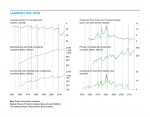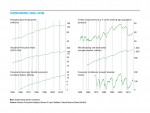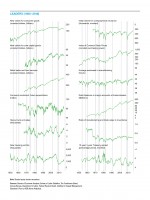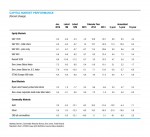Pulling It All Together/Appendix
The Economy…
Our Leaders index fell to 38, the first drop into cautionary territory since 2007. The decline reflects spreading economic weakness. When combined with the softer performance of the core components in the overall economy, yellow caution lights begin to shine more brightly. However, with our Leaders below 50 for just one month and given that the data underlying the indicators are subject to future revisions, we are not ready to declare that a recession is likely.
…Inflation…
Inflationary pressures stayed firm because of strong consumer demand and rising producer prices. Consumers in February continued to see the effects of falling energy prices. But the drag from falling crude oil prices may be ending. Crude rebounded in March, but that change is not reflected in February’s Consumer Price Index data. As the transitory effect of cheap oil fades, the inflationary outlook over the medium term stayed positive.
…Policy…
The Federal Reserve kept interest rates unchanged in March. But the economic projections released following the March meeting of Fed policy makers suggest that rate hikes may occur later this year. However, the projections come amidst uncertainty, and the actual path of Fed policy will depend on data from the months ahead.
Inflationary pressures stayed firm because of strong consumer demand and rising producer prices. Consumers in February continued to see the effects of falling energy prices. But the drag from falling crude oil prices may be ending. Crude rebounded in March, but that change is not reflected in February’s Consumer Price Index data. As the transitory effect of cheap oil fades, the inflationary outlook over the medium term stayed positive.
…Policy…
The Federal Reserve kept interest rates unchanged in March. But the economic projections released following the March meeting of Fed policy makers suggest that rate hikes may occur later this year. However, the projections come amidst uncertainty, and the actual path of Fed policy will depend on data from the months ahead.
The federal budget deficit has diminished steadily since the recession ended in 2009. In 2015 it fell below its long-term average. But in 2016 the deficit is expected to rise, according to the latest projections. And the deficit would be even greater if a recession occurs.
…Investing
Two of our leading indicators are based on financial market data, namely inflation-adjusted stock prices and the Treasury yield curve. The signals from these two are mixed, with real stock prices trending lower while the yield curve continues to give a positive signal. While our job is not to forecast the Leaders but rather to understand the context of the results, digging a little deeper into each suggests a slightly more positive interpretation on these two data points.
Real stock prices are just one of 12 leading indicators in our Leaders diffusion index. While we don’t have comparable BCC models for other countries and regions around the world, a simple comparison of stock price performance suggests global economic growth may be more at risk than U.S. growth.
Food prices, like other commodities, are subject to cyclical forces. Over the past three decades, agricultural commodity prices have tended to trend similarly to other commodities. The most recent trend, since 2010, has been toward lower food prices, which has resulted in lower costs for food purchased for home consumption.
Next/Previous Section:
1.Overview
2. Economy
3. Inflation
4. Policy
5. Investing
6. Pulling It All Together/Appendix





